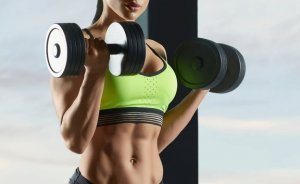The Role of Lactic Acid in Exercise

Lactic acid is a chemical compound that plays important roles in many biochemical processes such as lactic acid fermentation.
One of the body’s tissues that produces a lot of lactic acid is muscle, seismically when it uses carbohydrates for energy. This process is known as lactic fermentation.
In this article, we’re going to tell you all about this molecule.
Lactic Acid Production

Lactic acid is produced in your muscles when you perform strenuous exercise.
It’s produced mainly in muscle cells and red blood cells when the body breaks down carbohydrates for energy when oxygen levels are low. These levels decreases during intense exercise or when a person has an infection or disease.
Overall, the primary source of lactate is the breakdown of a carbohydrate called glycogen. This substance is a natural energy reserve formed by multiple chains of sugar (glucose). Their decomposition produces a lot of energy, so it’s one of the main sources of muscle.
However, using glucose requires oxygen. Therefore, this is a more lengthy process. In demanding situations, cells shorten the path and produce energy by fermentation. This is less effective. However, it’s faster.
While some cells have the ability to use pyruvate for energy, others can’t. That’s why the muscles produce a lot of lactate.
This article may interest you: Improve Your General Health With These Exercises
Lactic Acid and Muscles
This acid is actually a fuel, not a waste product. Therefore, muscles deliberately produce it from glucose and use it for energy.
Muscle cells are capable of converting glucose into lactic acid. Then, it’s cellular organelles called mitochondria absorb and use it. These organelles are responsible for energy production in cells.
Mitochondria have a characteristic protein to transport the lactic acid inside them. Thus, intense training causes the mitochondria to double and burn more lactic acid. As a result, the muscles work better.
Lactic Acid During Exercise

The body rare uses these fibers when the person is resting or doing light activities. After all, many require rapid activation and have little ability to convert pyruvate into energy. Therefore, the body converts a lot of pyruvate into lactate.
You should also read: Four Yoga Poses to Restore Your Energy
Lactate: A Very Dynamic Substance
When the body produces lactate, it seeks to enter other nearby muscles. This includes the bloodstream and the space between muscle cells, where the lactate concentration is lower.
When lactic acid manages to enter another muscle, it may re-convert into pyruvate to be used for aerobic energy.
The heart also uses lactate as fuel. In addition, it can go to the liver to be converted back into glucose and glycogen to restart the cycle.
Finally, it can also quickly travel from one body part to another. There’s even evidence that some lactate is converted back into glycogen in the muscles without necessarily going to the liver.
Overall, it’s a very amazing process!
All cited sources were thoroughly reviewed by our team to ensure their quality, reliability, currency, and validity. The bibliography of this article was considered reliable and of academic or scientific accuracy.
- Morell, A. M. M., González Millán, C., & Llop, F. (2007). Presente y futuro del ácido láctico. Archivos de Medicina Del Deporte.
- Soler Morejón, C. (2000). Acidosis láctica. Revista Cubana de Medicina. https://doi.org/10.1056 / NEJMra1309483
- Calderón-Montero, F. javier, Benito-Peinado, P. J., Melendez-Ortega, A., & González-Gross, M. (2006). Control biológico del entrenamiento de resistencia. (Biological control of endurance training.). RICYDE. Revista Internacional de Ciencias Del Deporte. https://doi.org/10.5232/ricyde2006.00205
This text is provided for informational purposes only and does not replace consultation with a professional. If in doubt, consult your specialist.








